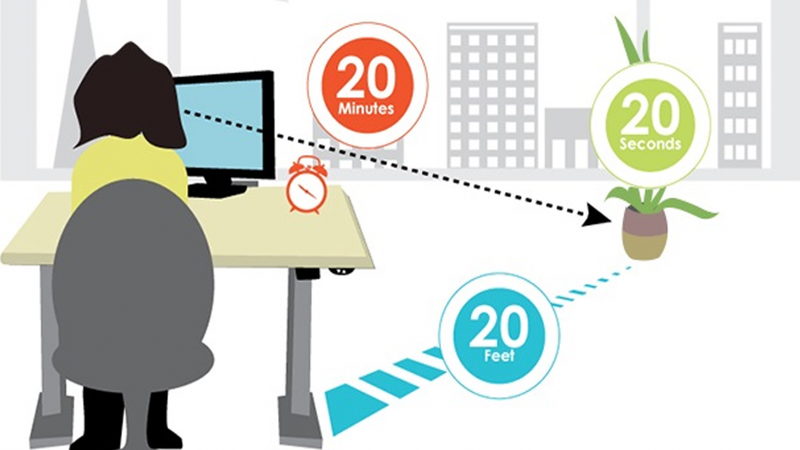Introduction

Eye strain is a common issue when working with screens for long hours
Eye strain is a frequent issue among those who work in offices, study, or spend time on computers, smartphones, and tablets every day. According to the American Academy of Ophthalmology (AAO), digital eye strain can lead to dry eyes, headaches, blurred vision, and even long-term impacts on quality of life.
This article analyzes five scientifically proven and practical methods to prevent eye strain, helping you maintain healthy eyes in the digital age.
The impacts of digital eye strain on the body
The effects of digital eye strain go beyond the eyes and extend to many aspects of overall health. In mild cases, patients often experience eye strain, blurred vision, and dryness. However, if the condition persists, systemic complications may appear.
One of the most noticeable effects is headaches and migraines. When the eyes are overworked for long periods to focus on screens, constant accommodation leads to visual fatigue, resulting in headaches. In severe cases, eye strain and eye pain may progress to migraines, accompanied by more serious symptoms such as nausea, light sensitivity, or even temporary blindness.
In addition, poor working posture can worsen the problem. Many people unconsciously adjust their neck, back, and shoulders to see more clearly when vision decreases due to eye strain. Maintaining this incorrect posture for long periods can lead to neck pain, back pain, and shoulder stiffness, reducing both quality of life and work performance.
1. The 20-20-20 rule – A classic method to reduce eye strain

Applying the 20-20-20 rule helps your eyes rest
When staring at screens continuously, blinking frequency decreases, leaving the corneal surface less hydrated. The 20-20-20 rule is an internationally recommended method: every 20 minutes, look away from the screen and focus on an object 20 feet (about 6 meters) away for 20 seconds. This duration is sufficient for the eye muscles to relax, reset, and restore tear film balance.
Consistently applying this rule can reduce eye strain symptoms by up to 40%, according to the National Eye Institute. You can also use reminder apps or timers to help maintain this habit effectively.
2. Adjust lighting and screen distance properly
Blue light from LED screens and improper working environments (too bright, too dark, or with glare) are major causes of eye fatigue. The distance from your eyes to the screen should be 50–70 cm, with the monitor placed about 10–15 degrees below eye level. Room lighting should be balanced, avoiding extreme contrast between the screen and surrounding environment.
| Factor | Recommendation |
|---|---|
| Screen distance | 50 – 70 cm |
| Viewing angle | 10–15° below eye level |
| Room lighting | Not too bright, minimize glare |
| Screen brightness | Balanced with ambient light |
3. Maintain eye hydration
Air conditioning, fans, or dry climates can cause tears to evaporate quickly, leading to dryness and eye strain. Supplementing with preservative-free artificial tears, combined with drinking at least 2 liters of water daily, helps keep the eyes naturally hydrated. International studies also show that omega-3 from salmon, chia seeds, and flaxseed oil significantly supports reducing dry eye symptoms.
Especially for contact lens wearers, extra hydration is essential, as lenses can disrupt tear circulation. Choosing suitable lubricating eye drops under medical advice helps prevent complications.
4. Use blue light blocking glasses for extended screen work

Blue light blocking glasses protect against eye strain and vision decline
Short-wavelength blue light from digital devices can penetrate deeply into the retina, causing cumulative damage to retinal cells. Blue light blocking glasses have been recognized by the American Optometric Association as an effective solution for reducing eye strain, especially for individuals working on computers 6–8 hours per day.
When combined with built-in device features such as “Night Shift” or “Blue Light Filter,” users may also experience improved sleep quality and reduced fatigue in the evening.
5. Routine eye exams and timely interventions
Many people underestimate the importance of eye exams, often visiting only when symptoms become severe. However, routine eye exams every 6–12 months can detect early issues such as chronic dry eye, progressive refractive errors, or digital eye strain. Doctors can then recommend appropriate treatments—from adjusting work habits and prescribing specialized eye drops to advanced interventions.
For prolonged eye strain due to high refractive errors, patients may consider modern solutions such as Phakic ICL – a cornea-preserving refractive surgery that reduces dependence on glasses and improves long-term vision quality.
Conclusion
Eye strain not only causes discomfort but also directly affects work performance and overall health. Taking proactive steps today—such as following the 20-20-20 rule, adjusting lighting, maintaining eye hydration, using blue light blocking glasses, and scheduling regular eye exams—is a smart investment in clear and healthy vision for the future.

 vi
vi 13-Sep-2025
13-Sep-2025










 0916.741.763
0916.741.763 Appointment
Appointment